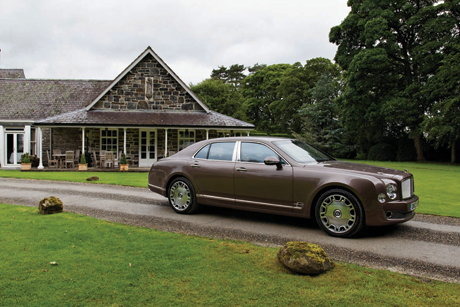Producing a Bentley means maintaining critical tolerances, involving precision tooling and skilled operators all of whom combine to achieve dizzy levels of dimensional accuracy and integrity.
Such attention to detail and craftsmanship of the whole manufacturing process makes a Bentley the prized possession of a car lover, says Visvas Paul D Karra after visiting the plant in Crewe, England.
Bentley is all about providing individual care and attention, not only at the production level of the car but also in catering to the bespoke demands of customers. Every car is made to order and involves exquisite craftsmanship, just like in the olden days when every Bentley that was on the road used to be unique piece of style and motion designed and built by clever coachbuilders.
The capacity for speed is an attractive attribute in a Bentley, but in manufacturing the finest motor cars, the quest for perfection cannot be hurried. It takes some eight days to achieve the level of finish and body protection synonymous with these vehicles.
One of the interesting aspects of producing a Bentley is that technology has been harnessed for speed, but all the core skills remain in the hands of humans. For instance, every Bentley’s interior veneer is unique as it is marked with the chassis number of the car for which it is intended. It takes 13 days to produce a set of veneers for one Bentley with 80 craftsmen working in the Wood Shop.
The distinctive burr walnut pattern is produced over years by a fungus, which affects the root ball, and become more valuable than the trees, which have passed their best as fruit producers. Every tree felled is replaced by another. Burr walnut is the most familiar but by no means the only veneer used at Crewe. English oak is also available, as is the increasingly rare elm, and the company has introduced two woods, madrona and vavona.
Endangered varieties such as mahogany are not used. Birds eye maple is another wood to provide a distinctive grainy pattern, though it is also the hardest to work with. Some customers opt for straight-grain walnut veneers, and solid walnut is used for parts of the car, such as the waist rails.
Mirror image
It is the job of Veneer Selector Adrian Minshull to travel to Italy and elsewhere to meet the importers of root balls. He can provide an accurate estimate of how many car interiors can be veneered once the ball has been sliced into 0.6mm leaves.
The Wood Shop uses 16 leaves to create the 26 central components in a Bentley, plus another eight for the waist rails. Options such as picnic tables or additional door panels could bring the veneer used in a Bentley to as much as 6.5sq m (21.3sq ft).
Making full use of the recurring pattern throughout the root or log, the leaves are doubled up to create a mirror-image effect. For example, four leaves are taped end to end to form a symmetrical pattern across the centreline of the facia, and this pattern is matched and echoed in the console to create a cascading effect throughout the vehicle. The waist rails also mirror each other, with the same pattern repeated on each door.
Accuracy and integrity
Precision engineering is evident in the state-of-the-art Body Assembly Hall at Crewe. Where gaps are required between steel panels, for example, they are uniform, set at exactly 3.5mm.
Four-axis measuring machines check no fewer than 2,500 measuring points. In addition, the achievement of joints between body panels that are almost invisible is the result of abandoning standard “hot weld” technology, which can cause distortion of panels at the weld points. Instead, Crewe has adopted plasma-brazing “cold weld” technology, which leaves a pristine finish ready for painting.
Behind orange safety curtains, the plasma-welding teams can be seen at work on the major body assemblies. Elsewhere in the hall, suspended computer-controlled guns are used to assemble body sections mounted on jigs. These hand-held tools allow accurate positioning of the 6,500 spot welds required to optimise torsional rigidity on each monocoque steel bodyshell. No other manufacturer goes in for spot-welding on this scale.
The visitor will notice that although there are fans to blow any fumes away from the welders, they raise only the lightest breeze. That is to avoid blowing dust around the Body Assembly Hall which, like every other area at Crewe, is conspicuously clean. Between 540 and 560 components are used to construct each body. By the time each one leaves the assembly hall, it will incorporate some 3m of MIG wire, 1.5m of brazing, and about 200 nuts.
It takes about three weeks to turn those 540-odd components into a complete, inspected bodyshell ready to go on to the next stage. Working a single eight-hour shift, the teams currently send 35 bodies on their way to the paintshop each week. And as each body goes on its way, it is already earmarked for one particular customer.
Gleaming perfection
The bare metal bodies pass through 16 stages of development and 120 separate processes before they depart in a state of gleaming perfection. There are 26 standard and a number of non-standard colours but since the latest product launch, 111 colours were individually matched. The paint shop is often asked to match a colour – to a bottle of nail lacquer or even a pink toothbrush.
“Ninety per cent of the materials applied to our car bodies are concerned solely with protection and ensuring a durable finish,” says John McNicholas, Zone Manager in the Auto Paint Shop. The other 10 per cent is about aesthetics. But what aesthetics! The first thing you notice when you look at a Bentley is how lovely the paintwork looks.
A process that can take eight days is telescoped into less than an hour when you walk alongside the conveyors in the Paint Shop at Crewe (there are 2.2 miles of track altogether!). Here, in one of the most advanced facilities of its kind, a procession of bodies arrive in bare white metal and will pass through 16 stages of development and 120 separate processes before they are ready to depart in a state of gleaming perfection. John is responsible for production planning, personnel and quality control.
The comfort zone
Mike Garnett, known to everyone as Slim, has worked at Crewe for 35 years. He is a man absorbed in the craft of working with leather, and in the many ways in which this and other fabrics can be made to soften the feel of a vehicle and make it a luxurious haven for its owner.
His knowledge is wide-ranging and detailed and his skill extraordinary. “We can do, and have done, everything a customer wants,” he says. “If you want a car interior designed in the style of a room in your house, or to match the tie you’re wearing, we can arrange that. We have used ostrich hide, cavalry twill, and velvets. It’s the same with colours – there are 17 standard ones, but we have been asked by ladies to match the nail varnish they are wearing, and by princesses to satisfy their taste in haute couture fabrics. We have always, so far, been able to meet their exact requirements.”
How many hides does it take to trim a Bentley? The 9-17 cows whose hide is needed to trim one will all have been reared principally for their meat but the hide that is the by-product is the very finest, and each one will provide around 46sq ft (4.27sq m) of leather.
Bentley has invested half a million pounds in state-of-the-art cutting equipment. With the use of a multi tool cutting head this equipment enables us to achieve cutting accuracy of 0.1mm on all of the 400 or so hide panels it takes to make up an interior of a Bentley. Many tasks, such as lining up stitch-lines in top rolls or the fluting in seats, or trimming into tight corners, require consummate skill.
Fabricated items such as seats have to be electronically tested before they are transferred into the car. The final audit under bright inspection lights is comprehensive and will reveal any area that requires reworking. It takes an average of six days to produce the finished leather trim for each Bentley.






